Mentoring and NCLEX Success: A Study of Minority Nursing Students
VerifiedAdded on 2022/07/29
|15
|3962
|232
Report
AI Summary
This report investigates the mentoring experiences of minority nursing (MN) students in accelerated Bachelor of Science in Nursing (BSN) programs within the southwestern United States. The study aims to determine if mentoring programs aid MN students in passing the Nursing Certification Licensure Examination (NCLEX) on their first attempt and facilitate their transition into professional nursing roles. The research explores the perspectives of both MN students and nurse educators, examining the challenges and successes encountered during NCLEX preparation and the transition to professional practice. The study employs a qualitative descriptive case study, utilizing semi-structured interviews with MN students and educators to gather data. Key research questions address how MN students and educators perceive mentoring, aiming to understand the impact of culturally efficient mentorship on academic and professional success. The findings are expected to contribute to nursing scholarship by identifying strategies to improve NCLEX success and enhance the retention of MN nurses in the healthcare field. The research is grounded in the universality and culture care diversity theory, emphasizing the importance of culturally congruent care and the role of mentors in supporting MN students. The study highlights the need for diverse nursing representation and the significance of cultural competence in healthcare delivery.

Paraphrase This Document
Need a fresh take? Get an instant paraphrase of this document with our AI Paraphraser
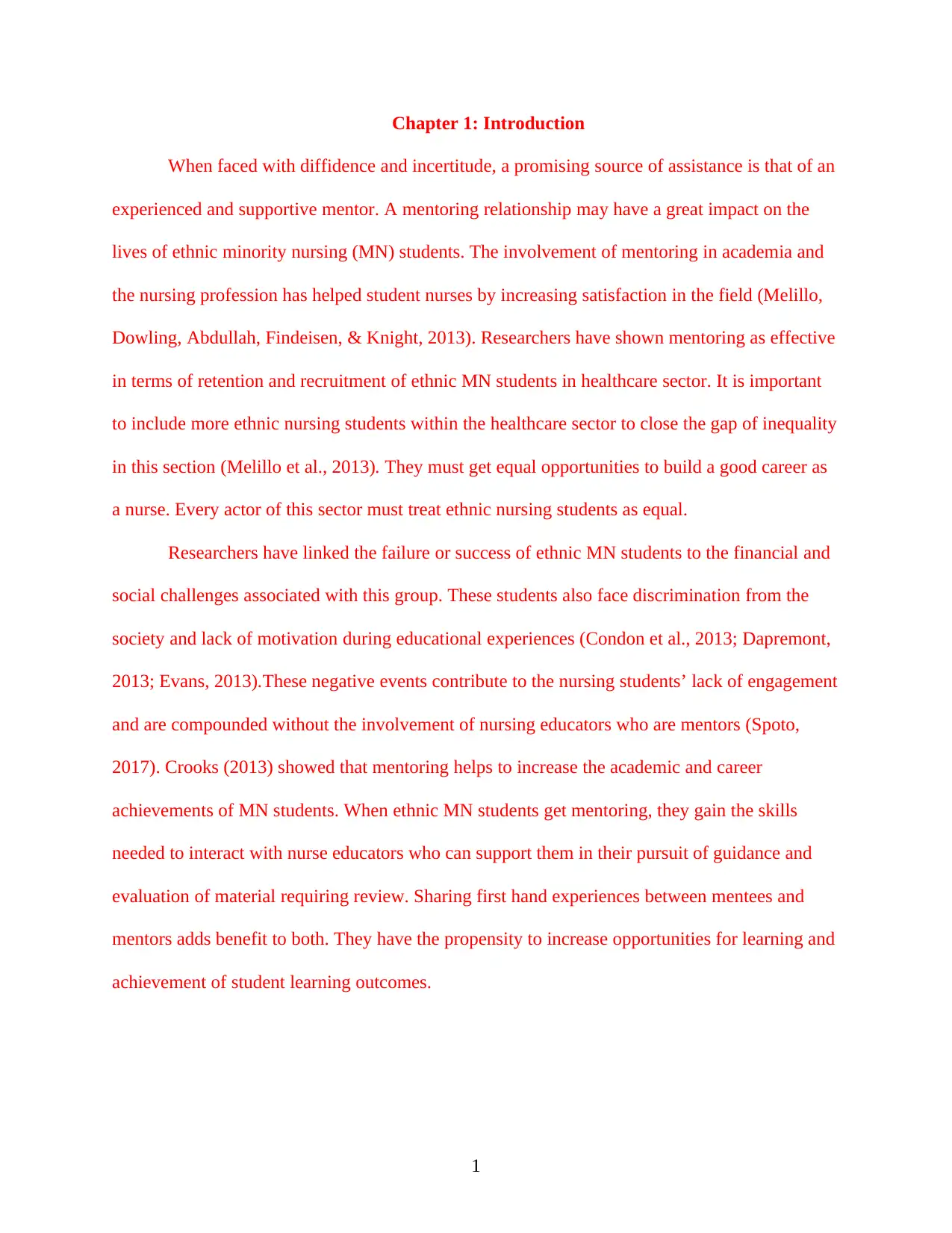
Chapter 1: Introduction
When faced with diffidence and incertitude, a promising source of assistance is that of an
experienced and supportive mentor. A mentoring relationship may have a great impact on the
lives of ethnic minority nursing (MN) students. The involvement of mentoring in academia and
the nursing profession has helped student nurses by increasing satisfaction in the field (Melillo,
Dowling, Abdullah, Findeisen, & Knight, 2013). Researchers have shown mentoring as effective
in terms of retention and recruitment of ethnic MN students in healthcare sector. It is important
to include more ethnic nursing students within the healthcare sector to close the gap of inequality
in this section (Melillo et al., 2013). They must get equal opportunities to build a good career as
a nurse. Every actor of this sector must treat ethnic nursing students as equal.
Researchers have linked the failure or success of ethnic MN students to the financial and
social challenges associated with this group. These students also face discrimination from the
society and lack of motivation during educational experiences (Condon et al., 2013; Dapremont,
2013; Evans, 2013).These negative events contribute to the nursing students’ lack of engagement
and are compounded without the involvement of nursing educators who are mentors (Spoto,
2017). Crooks (2013) showed that mentoring helps to increase the academic and career
achievements of MN students. When ethnic MN students get mentoring, they gain the skills
needed to interact with nurse educators who can support them in their pursuit of guidance and
evaluation of material requiring review. Sharing first hand experiences between mentees and
mentors adds benefit to both. They have the propensity to increase opportunities for learning and
achievement of student learning outcomes.
1
When faced with diffidence and incertitude, a promising source of assistance is that of an
experienced and supportive mentor. A mentoring relationship may have a great impact on the
lives of ethnic minority nursing (MN) students. The involvement of mentoring in academia and
the nursing profession has helped student nurses by increasing satisfaction in the field (Melillo,
Dowling, Abdullah, Findeisen, & Knight, 2013). Researchers have shown mentoring as effective
in terms of retention and recruitment of ethnic MN students in healthcare sector. It is important
to include more ethnic nursing students within the healthcare sector to close the gap of inequality
in this section (Melillo et al., 2013). They must get equal opportunities to build a good career as
a nurse. Every actor of this sector must treat ethnic nursing students as equal.
Researchers have linked the failure or success of ethnic MN students to the financial and
social challenges associated with this group. These students also face discrimination from the
society and lack of motivation during educational experiences (Condon et al., 2013; Dapremont,
2013; Evans, 2013).These negative events contribute to the nursing students’ lack of engagement
and are compounded without the involvement of nursing educators who are mentors (Spoto,
2017). Crooks (2013) showed that mentoring helps to increase the academic and career
achievements of MN students. When ethnic MN students get mentoring, they gain the skills
needed to interact with nurse educators who can support them in their pursuit of guidance and
evaluation of material requiring review. Sharing first hand experiences between mentees and
mentors adds benefit to both. They have the propensity to increase opportunities for learning and
achievement of student learning outcomes.
1
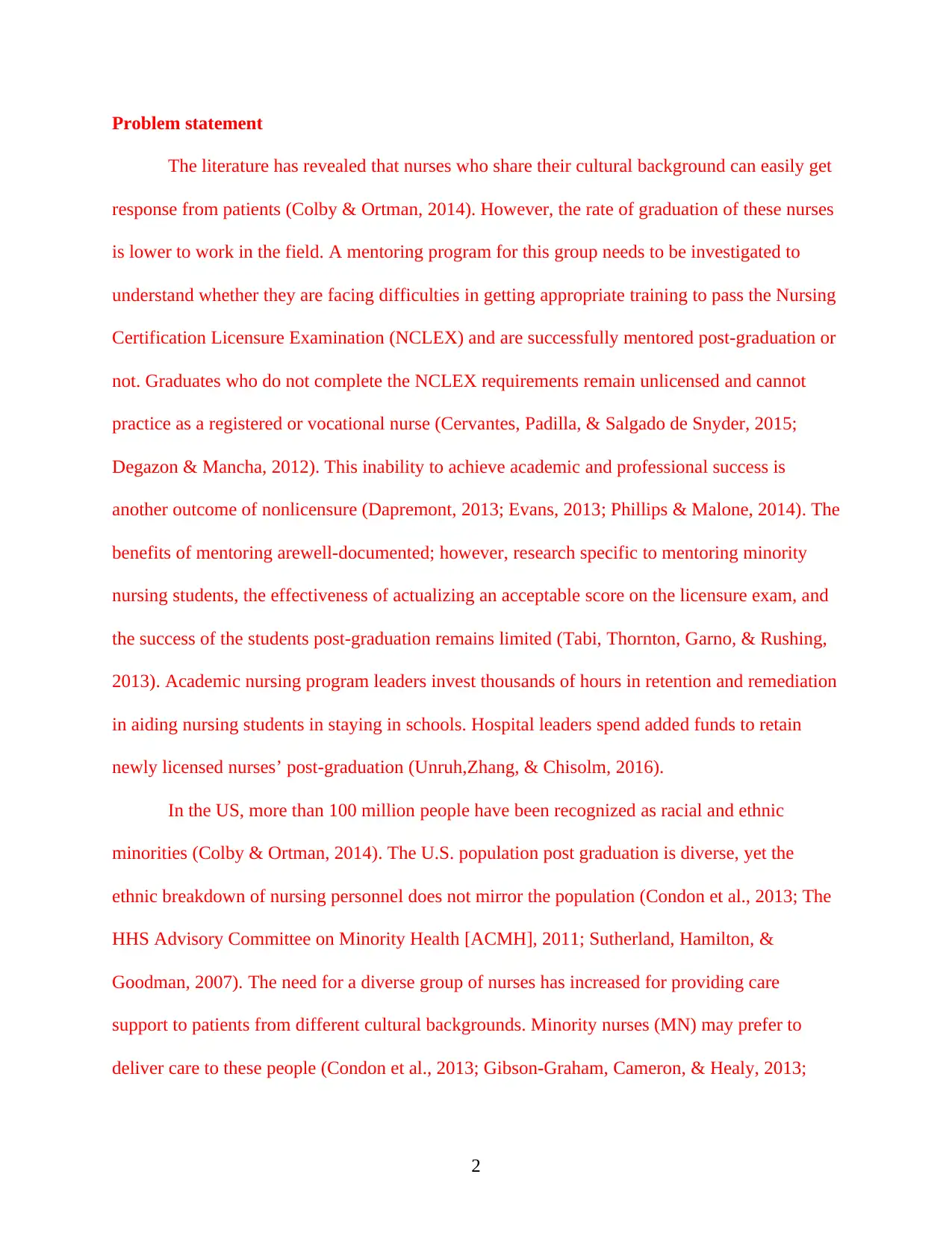
Problem statement
The literature has revealed that nurses who share their cultural background can easily get
response from patients (Colby & Ortman, 2014). However, the rate of graduation of these nurses
is lower to work in the field. A mentoring program for this group needs to be investigated to
understand whether they are facing difficulties in getting appropriate training to pass the Nursing
Certification Licensure Examination (NCLEX) and are successfully mentored post-graduation or
not. Graduates who do not complete the NCLEX requirements remain unlicensed and cannot
practice as a registered or vocational nurse (Cervantes, Padilla, & Salgado de Snyder, 2015;
Degazon & Mancha, 2012). This inability to achieve academic and professional success is
another outcome of nonlicensure (Dapremont, 2013; Evans, 2013; Phillips & Malone, 2014). The
benefits of mentoring arewell-documented; however, research specific to mentoring minority
nursing students, the effectiveness of actualizing an acceptable score on the licensure exam, and
the success of the students post-graduation remains limited (Tabi, Thornton, Garno, & Rushing,
2013). Academic nursing program leaders invest thousands of hours in retention and remediation
in aiding nursing students in staying in schools. Hospital leaders spend added funds to retain
newly licensed nurses’ post-graduation (Unruh,Zhang, & Chisolm, 2016).
In the US, more than 100 million people have been recognized as racial and ethnic
minorities (Colby & Ortman, 2014). The U.S. population post graduation is diverse, yet the
ethnic breakdown of nursing personnel does not mirror the population (Condon et al., 2013; The
HHS Advisory Committee on Minority Health [ACMH], 2011; Sutherland, Hamilton, &
Goodman, 2007). The need for a diverse group of nurses has increased for providing care
support to patients from different cultural backgrounds. Minority nurses (MN) may prefer to
deliver care to these people (Condon et al., 2013; Gibson-Graham, Cameron, & Healy, 2013;
2
The literature has revealed that nurses who share their cultural background can easily get
response from patients (Colby & Ortman, 2014). However, the rate of graduation of these nurses
is lower to work in the field. A mentoring program for this group needs to be investigated to
understand whether they are facing difficulties in getting appropriate training to pass the Nursing
Certification Licensure Examination (NCLEX) and are successfully mentored post-graduation or
not. Graduates who do not complete the NCLEX requirements remain unlicensed and cannot
practice as a registered or vocational nurse (Cervantes, Padilla, & Salgado de Snyder, 2015;
Degazon & Mancha, 2012). This inability to achieve academic and professional success is
another outcome of nonlicensure (Dapremont, 2013; Evans, 2013; Phillips & Malone, 2014). The
benefits of mentoring arewell-documented; however, research specific to mentoring minority
nursing students, the effectiveness of actualizing an acceptable score on the licensure exam, and
the success of the students post-graduation remains limited (Tabi, Thornton, Garno, & Rushing,
2013). Academic nursing program leaders invest thousands of hours in retention and remediation
in aiding nursing students in staying in schools. Hospital leaders spend added funds to retain
newly licensed nurses’ post-graduation (Unruh,Zhang, & Chisolm, 2016).
In the US, more than 100 million people have been recognized as racial and ethnic
minorities (Colby & Ortman, 2014). The U.S. population post graduation is diverse, yet the
ethnic breakdown of nursing personnel does not mirror the population (Condon et al., 2013; The
HHS Advisory Committee on Minority Health [ACMH], 2011; Sutherland, Hamilton, &
Goodman, 2007). The need for a diverse group of nurses has increased for providing care
support to patients from different cultural backgrounds. Minority nurses (MN) may prefer to
deliver care to these people (Condon et al., 2013; Gibson-Graham, Cameron, & Healy, 2013;
2
⊘ This is a preview!⊘
Do you want full access?
Subscribe today to unlock all pages.

Trusted by 1+ million students worldwide
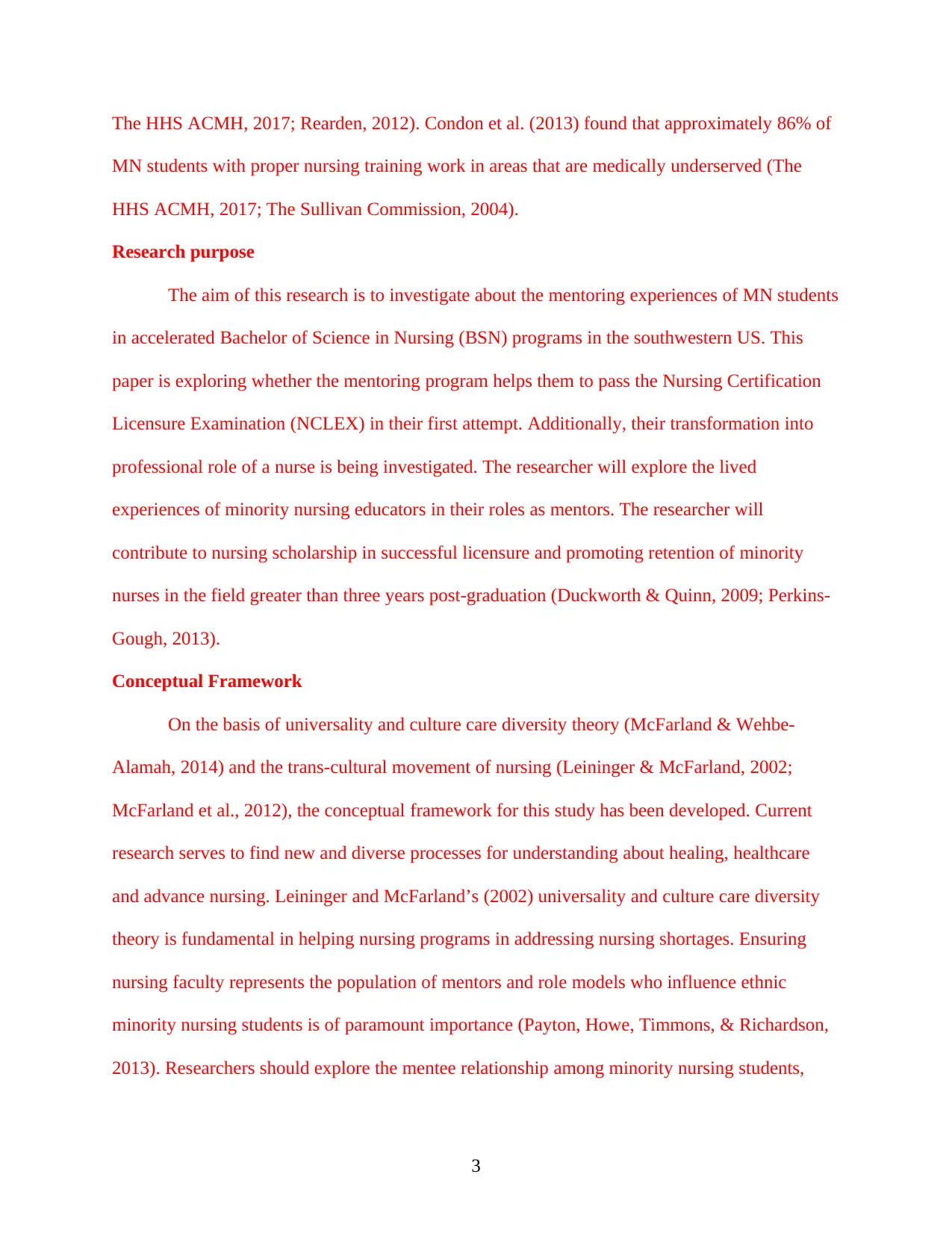
The HHS ACMH, 2017; Rearden, 2012). Condon et al. (2013) found that approximately 86% of
MN students with proper nursing training work in areas that are medically underserved (The
HHS ACMH, 2017; The Sullivan Commission, 2004).
Research purpose
The aim of this research is to investigate about the mentoring experiences of MN students
in accelerated Bachelor of Science in Nursing (BSN) programs in the southwestern US. This
paper is exploring whether the mentoring program helps them to pass the Nursing Certification
Licensure Examination (NCLEX) in their first attempt. Additionally, their transformation into
professional role of a nurse is being investigated. The researcher will explore the lived
experiences of minority nursing educators in their roles as mentors. The researcher will
contribute to nursing scholarship in successful licensure and promoting retention of minority
nurses in the field greater than three years post-graduation (Duckworth & Quinn, 2009; Perkins-
Gough, 2013).
Conceptual Framework
On the basis of universality and culture care diversity theory (McFarland & Wehbe-
Alamah, 2014) and the trans-cultural movement of nursing (Leininger & McFarland, 2002;
McFarland et al., 2012), the conceptual framework for this study has been developed. Current
research serves to find new and diverse processes for understanding about healing, healthcare
and advance nursing. Leininger and McFarland’s (2002) universality and culture care diversity
theory is fundamental in helping nursing programs in addressing nursing shortages. Ensuring
nursing faculty represents the population of mentors and role models who influence ethnic
minority nursing students is of paramount importance (Payton, Howe, Timmons, & Richardson,
2013). Researchers should explore the mentee relationship among minority nursing students,
3
MN students with proper nursing training work in areas that are medically underserved (The
HHS ACMH, 2017; The Sullivan Commission, 2004).
Research purpose
The aim of this research is to investigate about the mentoring experiences of MN students
in accelerated Bachelor of Science in Nursing (BSN) programs in the southwestern US. This
paper is exploring whether the mentoring program helps them to pass the Nursing Certification
Licensure Examination (NCLEX) in their first attempt. Additionally, their transformation into
professional role of a nurse is being investigated. The researcher will explore the lived
experiences of minority nursing educators in their roles as mentors. The researcher will
contribute to nursing scholarship in successful licensure and promoting retention of minority
nurses in the field greater than three years post-graduation (Duckworth & Quinn, 2009; Perkins-
Gough, 2013).
Conceptual Framework
On the basis of universality and culture care diversity theory (McFarland & Wehbe-
Alamah, 2014) and the trans-cultural movement of nursing (Leininger & McFarland, 2002;
McFarland et al., 2012), the conceptual framework for this study has been developed. Current
research serves to find new and diverse processes for understanding about healing, healthcare
and advance nursing. Leininger and McFarland’s (2002) universality and culture care diversity
theory is fundamental in helping nursing programs in addressing nursing shortages. Ensuring
nursing faculty represents the population of mentors and role models who influence ethnic
minority nursing students is of paramount importance (Payton, Howe, Timmons, & Richardson,
2013). Researchers should explore the mentee relationship among minority nursing students,
3
Paraphrase This Document
Need a fresh take? Get an instant paraphrase of this document with our AI Paraphraser
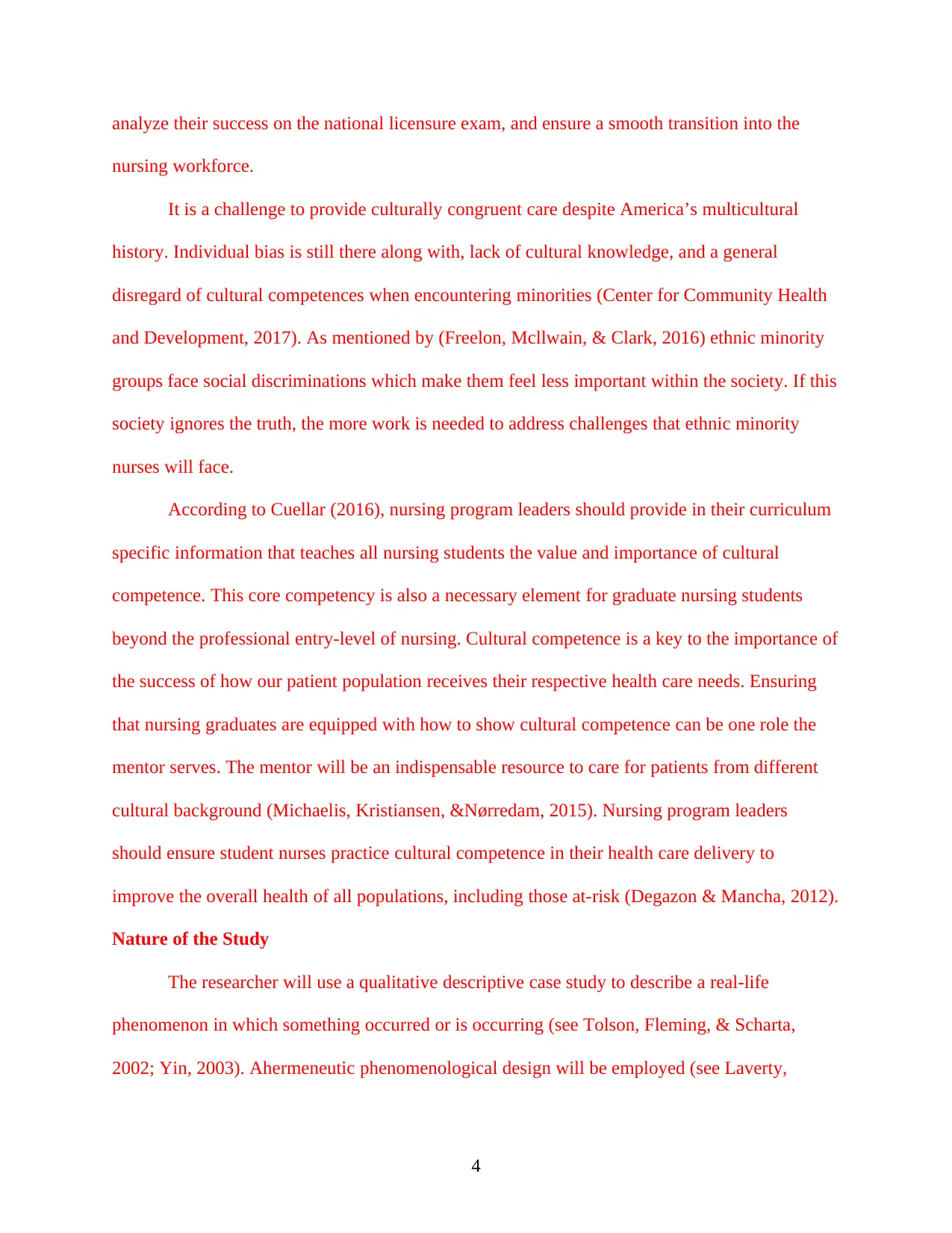
analyze their success on the national licensure exam, and ensure a smooth transition into the
nursing workforce.
It is a challenge to provide culturally congruent care despite America’s multicultural
history. Individual bias is still there along with, lack of cultural knowledge, and a general
disregard of cultural competences when encountering minorities (Center for Community Health
and Development, 2017). As mentioned by (Freelon, Mcllwain, & Clark, 2016) ethnic minority
groups face social discriminations which make them feel less important within the society. If this
society ignores the truth, the more work is needed to address challenges that ethnic minority
nurses will face.
According to Cuellar (2016), nursing program leaders should provide in their curriculum
specific information that teaches all nursing students the value and importance of cultural
competence. This core competency is also a necessary element for graduate nursing students
beyond the professional entry-level of nursing. Cultural competence is a key to the importance of
the success of how our patient population receives their respective health care needs. Ensuring
that nursing graduates are equipped with how to show cultural competence can be one role the
mentor serves. The mentor will be an indispensable resource to care for patients from different
cultural background (Michaelis, Kristiansen, &Nørredam, 2015). Nursing program leaders
should ensure student nurses practice cultural competence in their health care delivery to
improve the overall health of all populations, including those at-risk (Degazon & Mancha, 2012).
Nature of the Study
The researcher will use a qualitative descriptive case study to describe a real-life
phenomenon in which something occurred or is occurring (see Tolson, Fleming, & Scharta,
2002; Yin, 2003). Ahermeneutic phenomenological design will be employed (see Laverty,
4
nursing workforce.
It is a challenge to provide culturally congruent care despite America’s multicultural
history. Individual bias is still there along with, lack of cultural knowledge, and a general
disregard of cultural competences when encountering minorities (Center for Community Health
and Development, 2017). As mentioned by (Freelon, Mcllwain, & Clark, 2016) ethnic minority
groups face social discriminations which make them feel less important within the society. If this
society ignores the truth, the more work is needed to address challenges that ethnic minority
nurses will face.
According to Cuellar (2016), nursing program leaders should provide in their curriculum
specific information that teaches all nursing students the value and importance of cultural
competence. This core competency is also a necessary element for graduate nursing students
beyond the professional entry-level of nursing. Cultural competence is a key to the importance of
the success of how our patient population receives their respective health care needs. Ensuring
that nursing graduates are equipped with how to show cultural competence can be one role the
mentor serves. The mentor will be an indispensable resource to care for patients from different
cultural background (Michaelis, Kristiansen, &Nørredam, 2015). Nursing program leaders
should ensure student nurses practice cultural competence in their health care delivery to
improve the overall health of all populations, including those at-risk (Degazon & Mancha, 2012).
Nature of the Study
The researcher will use a qualitative descriptive case study to describe a real-life
phenomenon in which something occurred or is occurring (see Tolson, Fleming, & Scharta,
2002; Yin, 2003). Ahermeneutic phenomenological design will be employed (see Laverty,
4
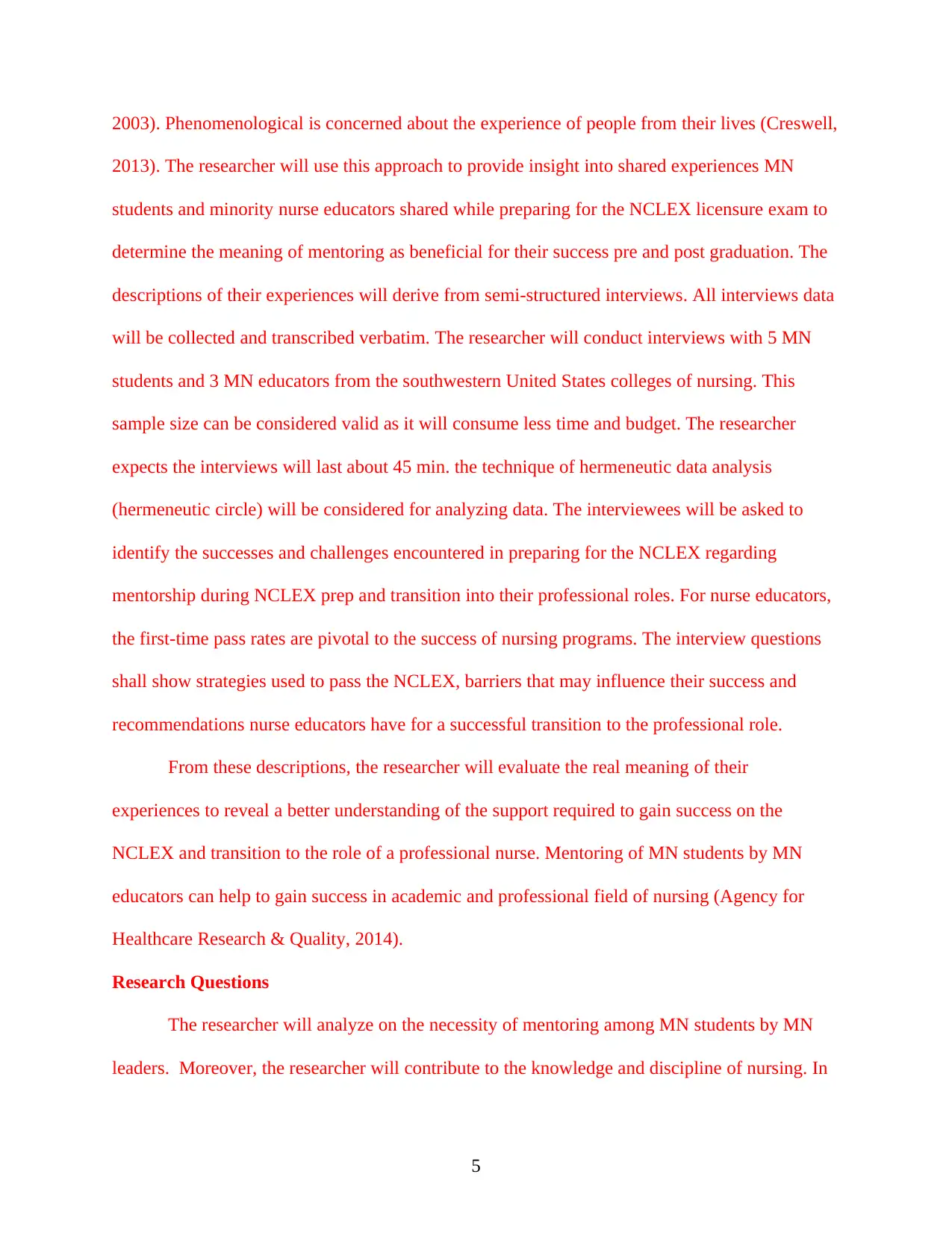
2003). Phenomenological is concerned about the experience of people from their lives (Creswell,
2013). The researcher will use this approach to provide insight into shared experiences MN
students and minority nurse educators shared while preparing for the NCLEX licensure exam to
determine the meaning of mentoring as beneficial for their success pre and post graduation. The
descriptions of their experiences will derive from semi-structured interviews. All interviews data
will be collected and transcribed verbatim. The researcher will conduct interviews with 5 MN
students and 3 MN educators from the southwestern United States colleges of nursing. This
sample size can be considered valid as it will consume less time and budget. The researcher
expects the interviews will last about 45 min. the technique of hermeneutic data analysis
(hermeneutic circle) will be considered for analyzing data. The interviewees will be asked to
identify the successes and challenges encountered in preparing for the NCLEX regarding
mentorship during NCLEX prep and transition into their professional roles. For nurse educators,
the first-time pass rates are pivotal to the success of nursing programs. The interview questions
shall show strategies used to pass the NCLEX, barriers that may influence their success and
recommendations nurse educators have for a successful transition to the professional role.
From these descriptions, the researcher will evaluate the real meaning of their
experiences to reveal a better understanding of the support required to gain success on the
NCLEX and transition to the role of a professional nurse. Mentoring of MN students by MN
educators can help to gain success in academic and professional field of nursing (Agency for
Healthcare Research & Quality, 2014).
Research Questions
The researcher will analyze on the necessity of mentoring among MN students by MN
leaders. Moreover, the researcher will contribute to the knowledge and discipline of nursing. In
5
2013). The researcher will use this approach to provide insight into shared experiences MN
students and minority nurse educators shared while preparing for the NCLEX licensure exam to
determine the meaning of mentoring as beneficial for their success pre and post graduation. The
descriptions of their experiences will derive from semi-structured interviews. All interviews data
will be collected and transcribed verbatim. The researcher will conduct interviews with 5 MN
students and 3 MN educators from the southwestern United States colleges of nursing. This
sample size can be considered valid as it will consume less time and budget. The researcher
expects the interviews will last about 45 min. the technique of hermeneutic data analysis
(hermeneutic circle) will be considered for analyzing data. The interviewees will be asked to
identify the successes and challenges encountered in preparing for the NCLEX regarding
mentorship during NCLEX prep and transition into their professional roles. For nurse educators,
the first-time pass rates are pivotal to the success of nursing programs. The interview questions
shall show strategies used to pass the NCLEX, barriers that may influence their success and
recommendations nurse educators have for a successful transition to the professional role.
From these descriptions, the researcher will evaluate the real meaning of their
experiences to reveal a better understanding of the support required to gain success on the
NCLEX and transition to the role of a professional nurse. Mentoring of MN students by MN
educators can help to gain success in academic and professional field of nursing (Agency for
Healthcare Research & Quality, 2014).
Research Questions
The researcher will analyze on the necessity of mentoring among MN students by MN
leaders. Moreover, the researcher will contribute to the knowledge and discipline of nursing. In
5
⊘ This is a preview!⊘
Do you want full access?
Subscribe today to unlock all pages.

Trusted by 1+ million students worldwide
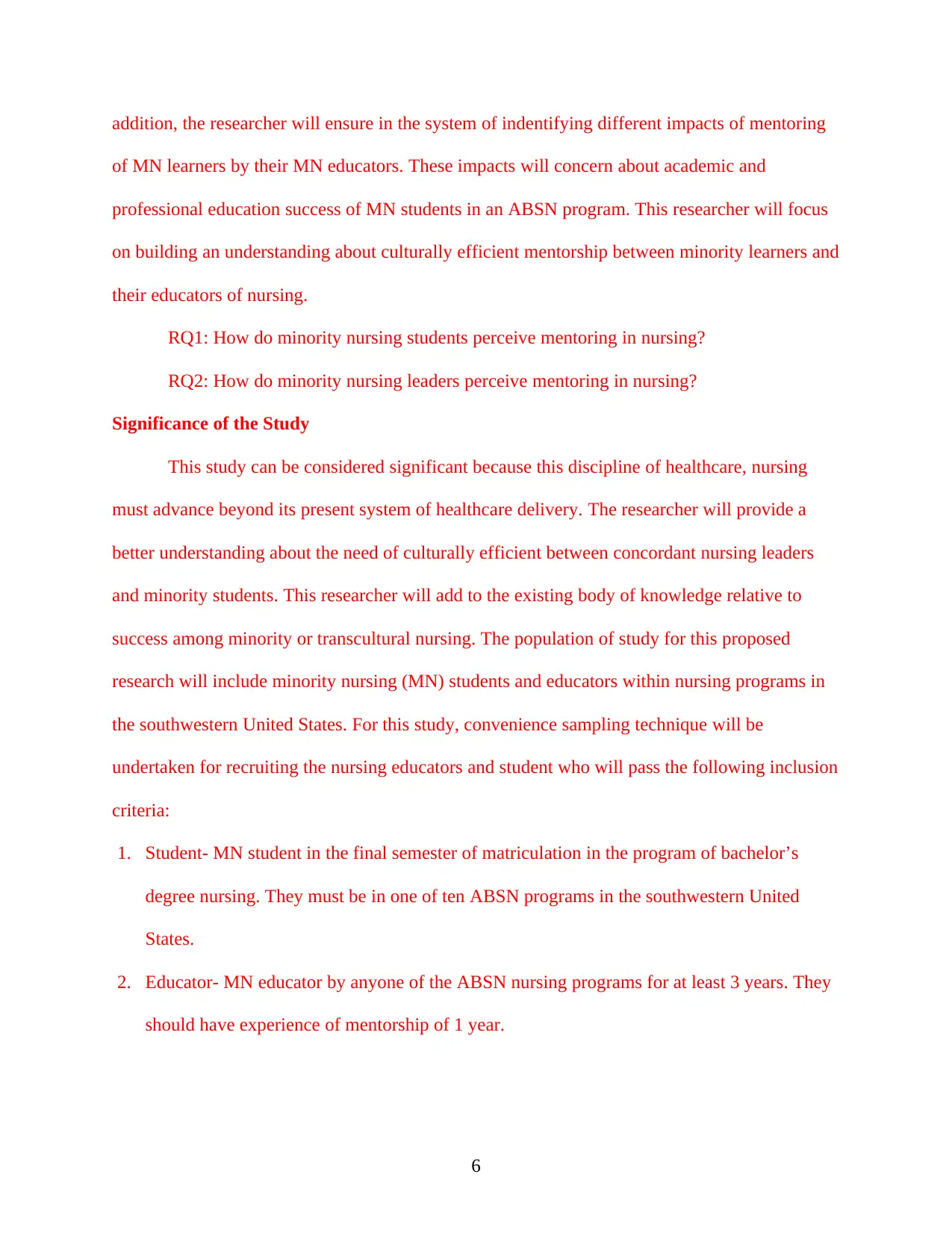
addition, the researcher will ensure in the system of indentifying different impacts of mentoring
of MN learners by their MN educators. These impacts will concern about academic and
professional education success of MN students in an ABSN program. This researcher will focus
on building an understanding about culturally efficient mentorship between minority learners and
their educators of nursing.
RQ1: How do minority nursing students perceive mentoring in nursing?
RQ2: How do minority nursing leaders perceive mentoring in nursing?
Significance of the Study
This study can be considered significant because this discipline of healthcare, nursing
must advance beyond its present system of healthcare delivery. The researcher will provide a
better understanding about the need of culturally efficient between concordant nursing leaders
and minority students. This researcher will add to the existing body of knowledge relative to
success among minority or transcultural nursing. The population of study for this proposed
research will include minority nursing (MN) students and educators within nursing programs in
the southwestern United States. For this study, convenience sampling technique will be
undertaken for recruiting the nursing educators and student who will pass the following inclusion
criteria:
1. Student- MN student in the final semester of matriculation in the program of bachelor’s
degree nursing. They must be in one of ten ABSN programs in the southwestern United
States.
2. Educator- MN educator by anyone of the ABSN nursing programs for at least 3 years. They
should have experience of mentorship of 1 year.
6
of MN learners by their MN educators. These impacts will concern about academic and
professional education success of MN students in an ABSN program. This researcher will focus
on building an understanding about culturally efficient mentorship between minority learners and
their educators of nursing.
RQ1: How do minority nursing students perceive mentoring in nursing?
RQ2: How do minority nursing leaders perceive mentoring in nursing?
Significance of the Study
This study can be considered significant because this discipline of healthcare, nursing
must advance beyond its present system of healthcare delivery. The researcher will provide a
better understanding about the need of culturally efficient between concordant nursing leaders
and minority students. This researcher will add to the existing body of knowledge relative to
success among minority or transcultural nursing. The population of study for this proposed
research will include minority nursing (MN) students and educators within nursing programs in
the southwestern United States. For this study, convenience sampling technique will be
undertaken for recruiting the nursing educators and student who will pass the following inclusion
criteria:
1. Student- MN student in the final semester of matriculation in the program of bachelor’s
degree nursing. They must be in one of ten ABSN programs in the southwestern United
States.
2. Educator- MN educator by anyone of the ABSN nursing programs for at least 3 years. They
should have experience of mentorship of 1 year.
6
Paraphrase This Document
Need a fresh take? Get an instant paraphrase of this document with our AI Paraphraser
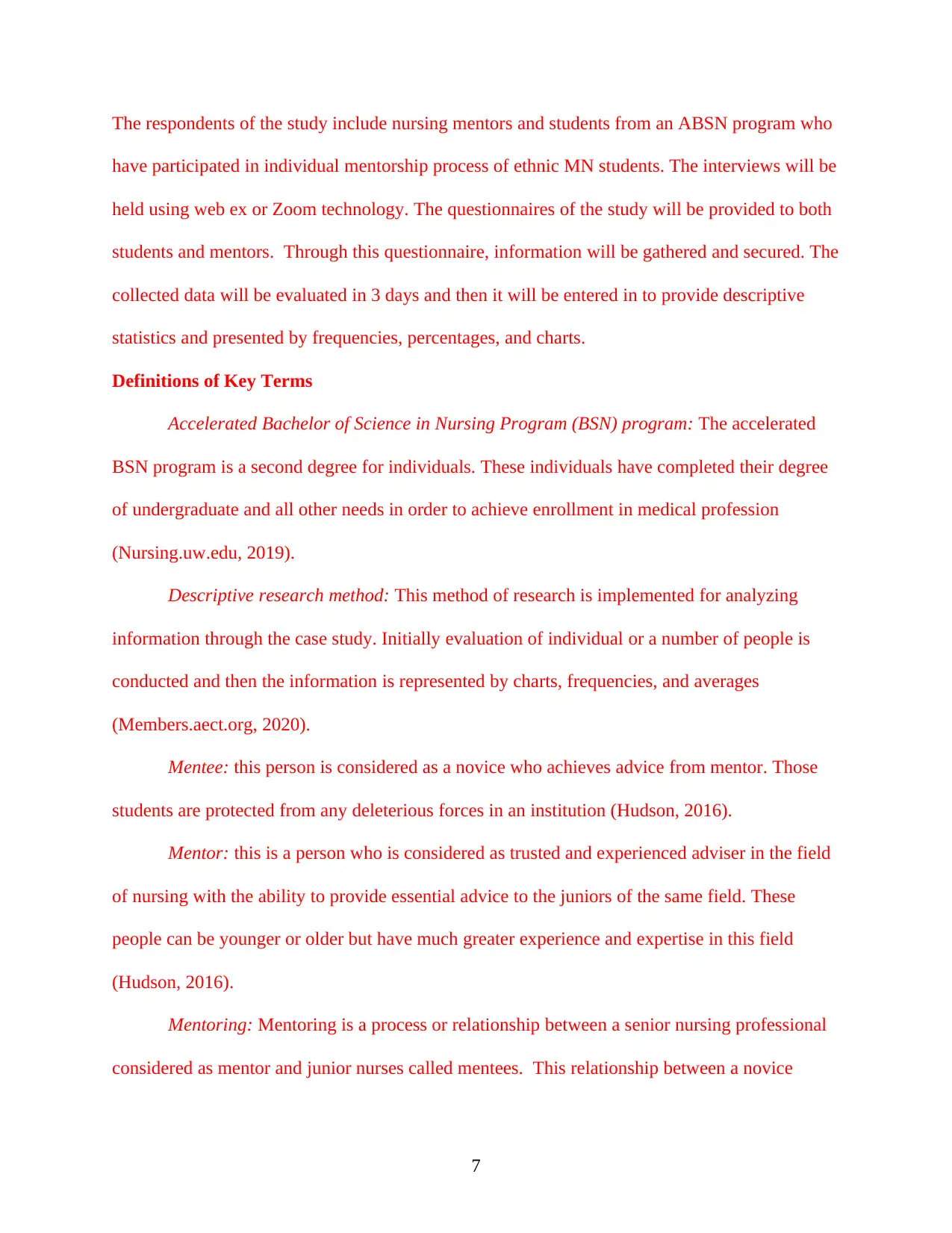
The respondents of the study include nursing mentors and students from an ABSN program who
have participated in individual mentorship process of ethnic MN students. The interviews will be
held using web ex or Zoom technology. The questionnaires of the study will be provided to both
students and mentors. Through this questionnaire, information will be gathered and secured. The
collected data will be evaluated in 3 days and then it will be entered in to provide descriptive
statistics and presented by frequencies, percentages, and charts.
Definitions of Key Terms
Accelerated Bachelor of Science in Nursing Program (BSN) program: The accelerated
BSN program is a second degree for individuals. These individuals have completed their degree
of undergraduate and all other needs in order to achieve enrollment in medical profession
(Nursing.uw.edu, 2019).
Descriptive research method: This method of research is implemented for analyzing
information through the case study. Initially evaluation of individual or a number of people is
conducted and then the information is represented by charts, frequencies, and averages
(Members.aect.org, 2020).
Mentee: this person is considered as a novice who achieves advice from mentor. Those
students are protected from any deleterious forces in an institution (Hudson, 2016).
Mentor: this is a person who is considered as trusted and experienced adviser in the field
of nursing with the ability to provide essential advice to the juniors of the same field. These
people can be younger or older but have much greater experience and expertise in this field
(Hudson, 2016).
Mentoring: Mentoring is a process or relationship between a senior nursing professional
considered as mentor and junior nurses called mentees. This relationship between a novice
7
have participated in individual mentorship process of ethnic MN students. The interviews will be
held using web ex or Zoom technology. The questionnaires of the study will be provided to both
students and mentors. Through this questionnaire, information will be gathered and secured. The
collected data will be evaluated in 3 days and then it will be entered in to provide descriptive
statistics and presented by frequencies, percentages, and charts.
Definitions of Key Terms
Accelerated Bachelor of Science in Nursing Program (BSN) program: The accelerated
BSN program is a second degree for individuals. These individuals have completed their degree
of undergraduate and all other needs in order to achieve enrollment in medical profession
(Nursing.uw.edu, 2019).
Descriptive research method: This method of research is implemented for analyzing
information through the case study. Initially evaluation of individual or a number of people is
conducted and then the information is represented by charts, frequencies, and averages
(Members.aect.org, 2020).
Mentee: this person is considered as a novice who achieves advice from mentor. Those
students are protected from any deleterious forces in an institution (Hudson, 2016).
Mentor: this is a person who is considered as trusted and experienced adviser in the field
of nursing with the ability to provide essential advice to the juniors of the same field. These
people can be younger or older but have much greater experience and expertise in this field
(Hudson, 2016).
Mentoring: Mentoring is a process or relationship between a senior nursing professional
considered as mentor and junior nurses called mentees. This relationship between a novice
7
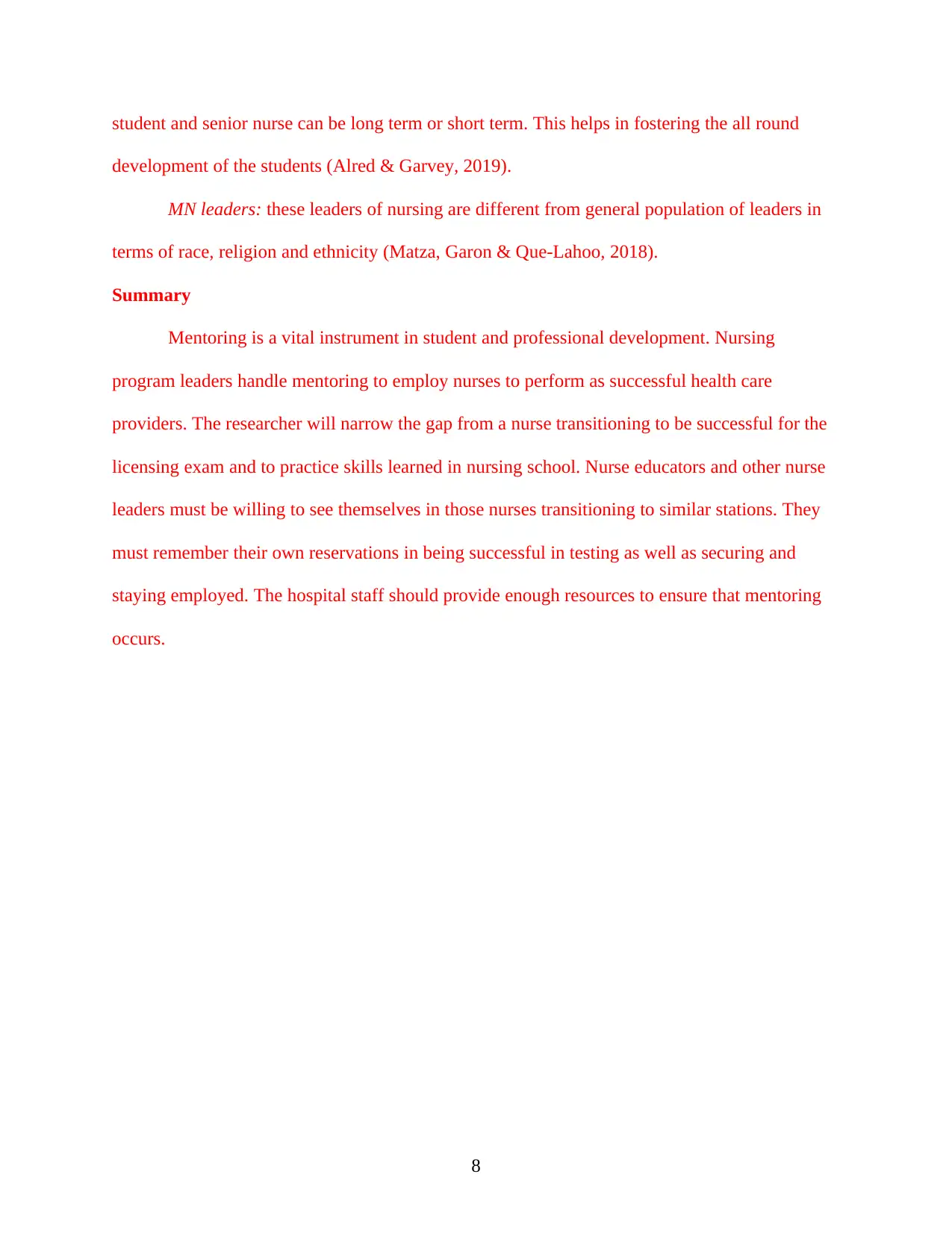
student and senior nurse can be long term or short term. This helps in fostering the all round
development of the students (Alred & Garvey, 2019).
MN leaders: these leaders of nursing are different from general population of leaders in
terms of race, religion and ethnicity (Matza, Garon & Que‐Lahoo, 2018).
Summary
Mentoring is a vital instrument in student and professional development. Nursing
program leaders handle mentoring to employ nurses to perform as successful health care
providers. The researcher will narrow the gap from a nurse transitioning to be successful for the
licensing exam and to practice skills learned in nursing school. Nurse educators and other nurse
leaders must be willing to see themselves in those nurses transitioning to similar stations. They
must remember their own reservations in being successful in testing as well as securing and
staying employed. The hospital staff should provide enough resources to ensure that mentoring
occurs.
8
development of the students (Alred & Garvey, 2019).
MN leaders: these leaders of nursing are different from general population of leaders in
terms of race, religion and ethnicity (Matza, Garon & Que‐Lahoo, 2018).
Summary
Mentoring is a vital instrument in student and professional development. Nursing
program leaders handle mentoring to employ nurses to perform as successful health care
providers. The researcher will narrow the gap from a nurse transitioning to be successful for the
licensing exam and to practice skills learned in nursing school. Nurse educators and other nurse
leaders must be willing to see themselves in those nurses transitioning to similar stations. They
must remember their own reservations in being successful in testing as well as securing and
staying employed. The hospital staff should provide enough resources to ensure that mentoring
occurs.
8
⊘ This is a preview!⊘
Do you want full access?
Subscribe today to unlock all pages.

Trusted by 1+ million students worldwide
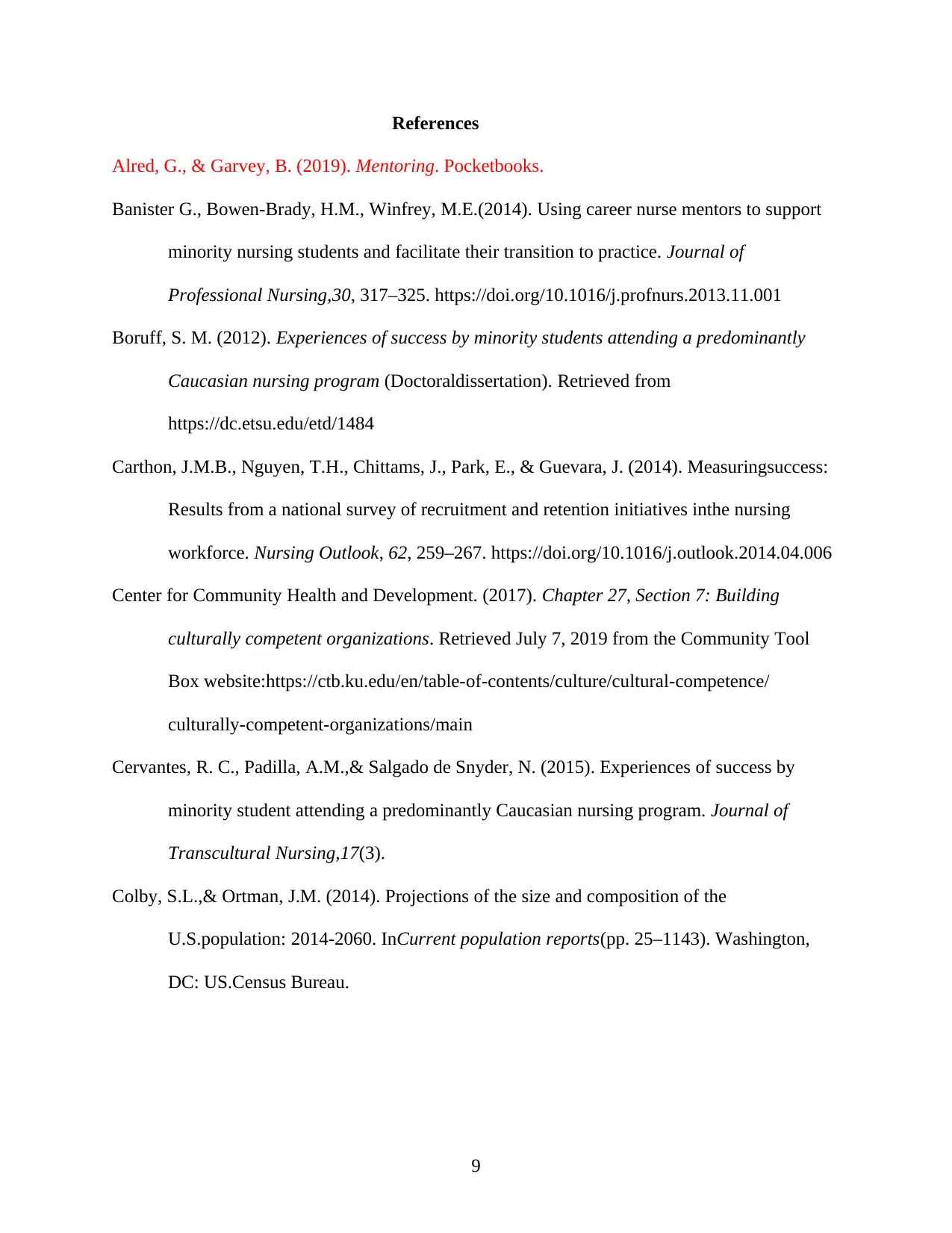
References
Alred, G., & Garvey, B. (2019). Mentoring. Pocketbooks.
Banister G., Bowen-Brady, H.M., Winfrey, M.E.(2014). Using career nurse mentors to support
minority nursing students and facilitate their transition to practice. Journal of
Professional Nursing,30, 317–325. https://doi.org/10.1016/j.profnurs.2013.11.001
Boruff, S. M. (2012). Experiences of success by minority students attending a predominantly
Caucasian nursing program (Doctoraldissertation). Retrieved from
https://dc.etsu.edu/etd/1484
Carthon, J.M.B., Nguyen, T.H., Chittams, J., Park, E., & Guevara, J. (2014). Measuringsuccess:
Results from a national survey of recruitment and retention initiatives inthe nursing
workforce. Nursing Outlook, 62, 259–267. https://doi.org/10.1016/j.outlook.2014.04.006
Center for Community Health and Development. (2017). Chapter 27, Section 7: Building
culturally competent organizations. Retrieved July 7, 2019 from the Community Tool
Box website:https://ctb.ku.edu/en/table-of-contents/culture/cultural-competence/
culturally-competent-organizations/main
Cervantes, R. C., Padilla, A.M.,& Salgado de Snyder, N. (2015). Experiences of success by
minority student attending a predominantly Caucasian nursing program. Journal of
Transcultural Nursing,17(3).
Colby, S.L.,& Ortman, J.M. (2014). Projections of the size and composition of the
U.S.population: 2014-2060. InCurrent population reports(pp. 25–1143). Washington,
DC: US.Census Bureau.
9
Alred, G., & Garvey, B. (2019). Mentoring. Pocketbooks.
Banister G., Bowen-Brady, H.M., Winfrey, M.E.(2014). Using career nurse mentors to support
minority nursing students and facilitate their transition to practice. Journal of
Professional Nursing,30, 317–325. https://doi.org/10.1016/j.profnurs.2013.11.001
Boruff, S. M. (2012). Experiences of success by minority students attending a predominantly
Caucasian nursing program (Doctoraldissertation). Retrieved from
https://dc.etsu.edu/etd/1484
Carthon, J.M.B., Nguyen, T.H., Chittams, J., Park, E., & Guevara, J. (2014). Measuringsuccess:
Results from a national survey of recruitment and retention initiatives inthe nursing
workforce. Nursing Outlook, 62, 259–267. https://doi.org/10.1016/j.outlook.2014.04.006
Center for Community Health and Development. (2017). Chapter 27, Section 7: Building
culturally competent organizations. Retrieved July 7, 2019 from the Community Tool
Box website:https://ctb.ku.edu/en/table-of-contents/culture/cultural-competence/
culturally-competent-organizations/main
Cervantes, R. C., Padilla, A.M.,& Salgado de Snyder, N. (2015). Experiences of success by
minority student attending a predominantly Caucasian nursing program. Journal of
Transcultural Nursing,17(3).
Colby, S.L.,& Ortman, J.M. (2014). Projections of the size and composition of the
U.S.population: 2014-2060. InCurrent population reports(pp. 25–1143). Washington,
DC: US.Census Bureau.
9
Paraphrase This Document
Need a fresh take? Get an instant paraphrase of this document with our AI Paraphraser
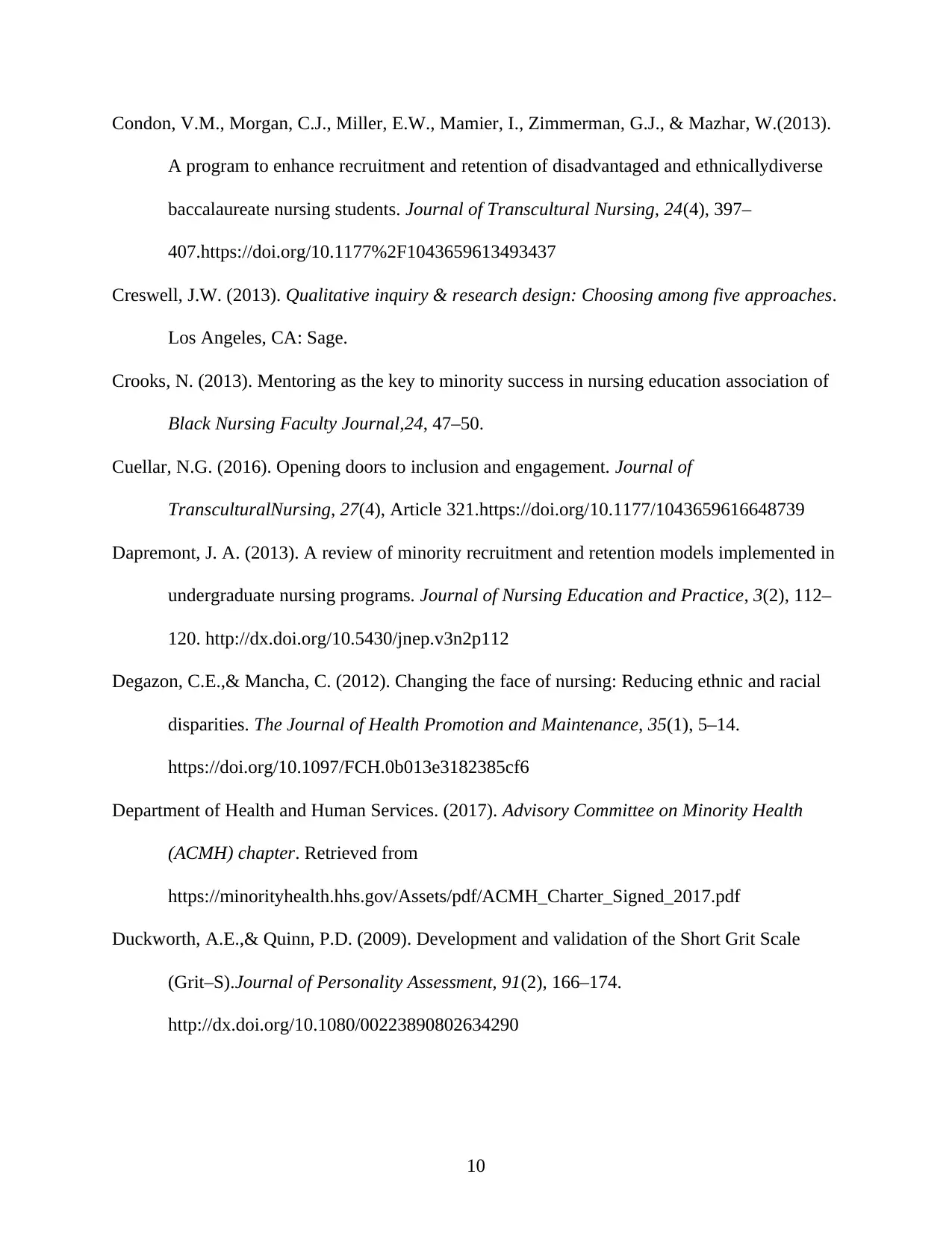
Condon, V.M., Morgan, C.J., Miller, E.W., Mamier, I., Zimmerman, G.J., & Mazhar, W.(2013).
A program to enhance recruitment and retention of disadvantaged and ethnicallydiverse
baccalaureate nursing students. Journal of Transcultural Nursing, 24(4), 397–
407.https://doi.org/10.1177%2F1043659613493437
Creswell, J.W. (2013). Qualitative inquiry & research design: Choosing among five approaches.
Los Angeles, CA: Sage.
Crooks, N. (2013). Mentoring as the key to minority success in nursing education association of
Black Nursing Faculty Journal,24, 47–50.
Cuellar, N.G. (2016). Opening doors to inclusion and engagement. Journal of
TransculturalNursing, 27(4), Article 321.https://doi.org/10.1177/1043659616648739
Dapremont, J. A. (2013). A review of minority recruitment and retention models implemented in
undergraduate nursing programs. Journal of Nursing Education and Practice, 3(2), 112–
120. http://dx.doi.org/10.5430/jnep.v3n2p112
Degazon, C.E.,& Mancha, C. (2012). Changing the face of nursing: Reducing ethnic and racial
disparities. The Journal of Health Promotion and Maintenance, 35(1), 5–14.
https://doi.org/10.1097/FCH.0b013e3182385cf6
Department of Health and Human Services. (2017). Advisory Committee on Minority Health
(ACMH) chapter. Retrieved from
https://minorityhealth.hhs.gov/Assets/pdf/ACMH_Charter_Signed_2017.pdf
Duckworth, A.E.,& Quinn, P.D. (2009). Development and validation of the Short Grit Scale
(Grit–S).Journal of Personality Assessment, 91(2), 166–174.
http://dx.doi.org/10.1080/00223890802634290
10
A program to enhance recruitment and retention of disadvantaged and ethnicallydiverse
baccalaureate nursing students. Journal of Transcultural Nursing, 24(4), 397–
407.https://doi.org/10.1177%2F1043659613493437
Creswell, J.W. (2013). Qualitative inquiry & research design: Choosing among five approaches.
Los Angeles, CA: Sage.
Crooks, N. (2013). Mentoring as the key to minority success in nursing education association of
Black Nursing Faculty Journal,24, 47–50.
Cuellar, N.G. (2016). Opening doors to inclusion and engagement. Journal of
TransculturalNursing, 27(4), Article 321.https://doi.org/10.1177/1043659616648739
Dapremont, J. A. (2013). A review of minority recruitment and retention models implemented in
undergraduate nursing programs. Journal of Nursing Education and Practice, 3(2), 112–
120. http://dx.doi.org/10.5430/jnep.v3n2p112
Degazon, C.E.,& Mancha, C. (2012). Changing the face of nursing: Reducing ethnic and racial
disparities. The Journal of Health Promotion and Maintenance, 35(1), 5–14.
https://doi.org/10.1097/FCH.0b013e3182385cf6
Department of Health and Human Services. (2017). Advisory Committee on Minority Health
(ACMH) chapter. Retrieved from
https://minorityhealth.hhs.gov/Assets/pdf/ACMH_Charter_Signed_2017.pdf
Duckworth, A.E.,& Quinn, P.D. (2009). Development and validation of the Short Grit Scale
(Grit–S).Journal of Personality Assessment, 91(2), 166–174.
http://dx.doi.org/10.1080/00223890802634290
10
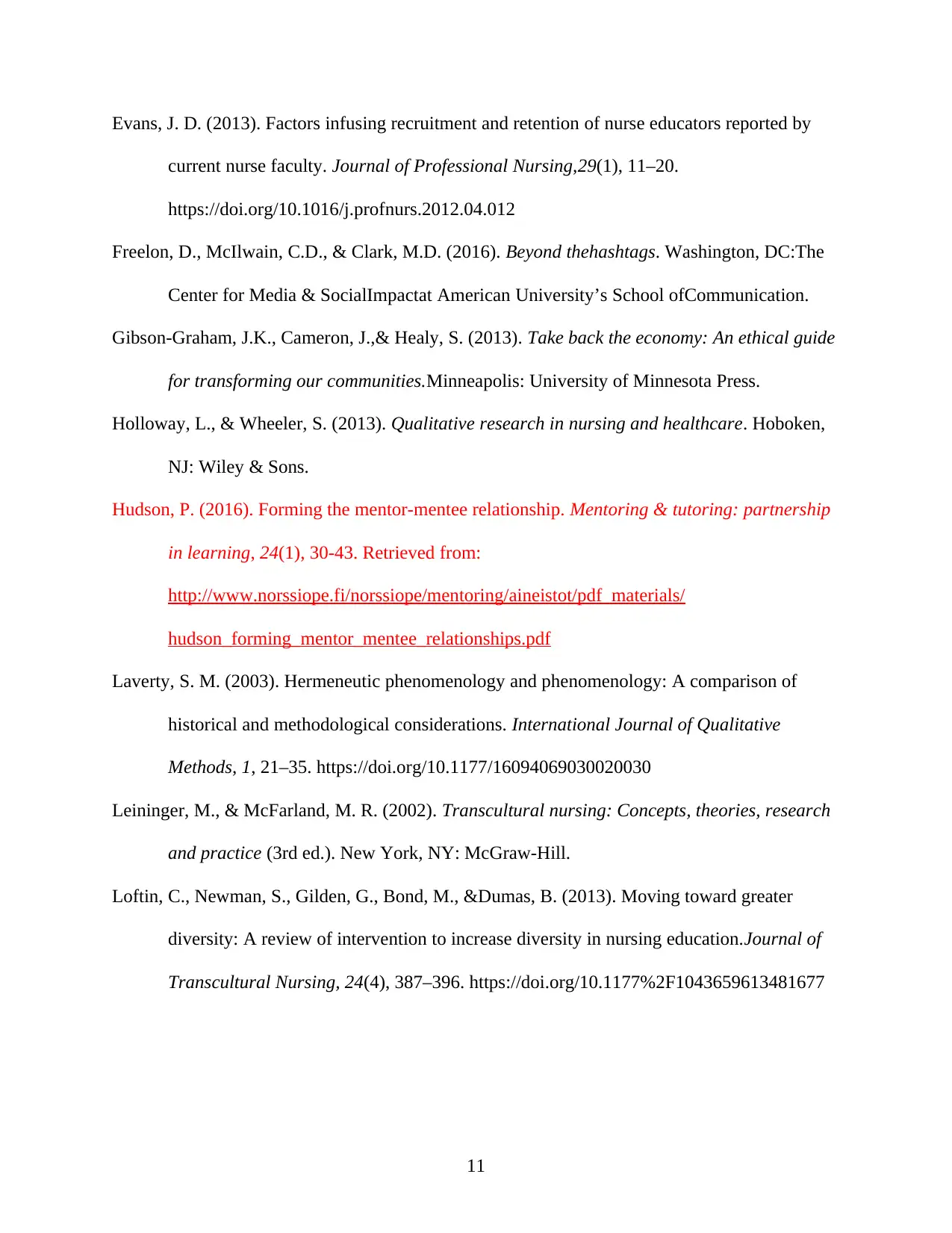
Evans, J. D. (2013). Factors infusing recruitment and retention of nurse educators reported by
current nurse faculty. Journal of Professional Nursing,29(1), 11–20.
https://doi.org/10.1016/j.profnurs.2012.04.012
Freelon, D., McIlwain, C.D., & Clark, M.D. (2016). Beyond thehashtags. Washington, DC:The
Center for Media & SocialImpactat American University’s School ofCommunication.
Gibson-Graham, J.K., Cameron, J.,& Healy, S. (2013). Take back the economy: An ethical guide
for transforming our communities.Minneapolis: University of Minnesota Press.
Holloway, L., & Wheeler, S. (2013). Qualitative research in nursing and healthcare. Hoboken,
NJ: Wiley & Sons.
Hudson, P. (2016). Forming the mentor-mentee relationship. Mentoring & tutoring: partnership
in learning, 24(1), 30-43. Retrieved from:
http://www.norssiope.fi/norssiope/mentoring/aineistot/pdf_materials/
hudson_forming_mentor_mentee_relationships.pdf
Laverty, S. M. (2003). Hermeneutic phenomenology and phenomenology: A comparison of
historical and methodological considerations. International Journal of Qualitative
Methods, 1, 21–35. https://doi.org/10.1177/16094069030020030
Leininger, M., & McFarland, M. R. (2002). Transcultural nursing: Concepts, theories, research
and practice (3rd ed.). New York, NY: McGraw-Hill.
Loftin, C., Newman, S., Gilden, G., Bond, M., &Dumas, B. (2013). Moving toward greater
diversity: A review of intervention to increase diversity in nursing education.Journal of
Transcultural Nursing, 24(4), 387–396. https://doi.org/10.1177%2F1043659613481677
11
current nurse faculty. Journal of Professional Nursing,29(1), 11–20.
https://doi.org/10.1016/j.profnurs.2012.04.012
Freelon, D., McIlwain, C.D., & Clark, M.D. (2016). Beyond thehashtags. Washington, DC:The
Center for Media & SocialImpactat American University’s School ofCommunication.
Gibson-Graham, J.K., Cameron, J.,& Healy, S. (2013). Take back the economy: An ethical guide
for transforming our communities.Minneapolis: University of Minnesota Press.
Holloway, L., & Wheeler, S. (2013). Qualitative research in nursing and healthcare. Hoboken,
NJ: Wiley & Sons.
Hudson, P. (2016). Forming the mentor-mentee relationship. Mentoring & tutoring: partnership
in learning, 24(1), 30-43. Retrieved from:
http://www.norssiope.fi/norssiope/mentoring/aineistot/pdf_materials/
hudson_forming_mentor_mentee_relationships.pdf
Laverty, S. M. (2003). Hermeneutic phenomenology and phenomenology: A comparison of
historical and methodological considerations. International Journal of Qualitative
Methods, 1, 21–35. https://doi.org/10.1177/16094069030020030
Leininger, M., & McFarland, M. R. (2002). Transcultural nursing: Concepts, theories, research
and practice (3rd ed.). New York, NY: McGraw-Hill.
Loftin, C., Newman, S., Gilden, G., Bond, M., &Dumas, B. (2013). Moving toward greater
diversity: A review of intervention to increase diversity in nursing education.Journal of
Transcultural Nursing, 24(4), 387–396. https://doi.org/10.1177%2F1043659613481677
11
⊘ This is a preview!⊘
Do you want full access?
Subscribe today to unlock all pages.

Trusted by 1+ million students worldwide
1 out of 15
Your All-in-One AI-Powered Toolkit for Academic Success.
+13062052269
info@desklib.com
Available 24*7 on WhatsApp / Email
![[object Object]](/_next/static/media/star-bottom.7253800d.svg)
Unlock your academic potential
Copyright © 2020–2025 A2Z Services. All Rights Reserved. Developed and managed by ZUCOL.